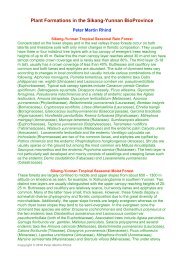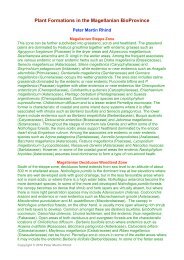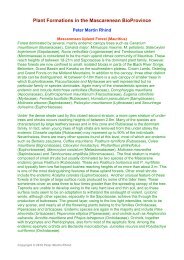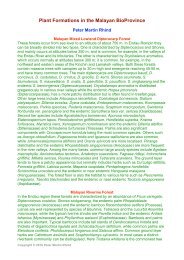Plant Formations in the Sumatran BioProvince - Terrestrial Biozones
Plant Formations in the Sumatran BioProvince - Terrestrial Biozones
Plant Formations in the Sumatran BioProvince - Terrestrial Biozones
Create successful ePaper yourself
Turn your PDF publications into a flip-book with our unique Google optimized e-Paper software.
<strong>Plant</strong> <strong>Formations</strong> <strong>in</strong> <strong>the</strong> <strong>Sumatran</strong> BioProv<strong>in</strong>ce<br />
Copyright © 2010 Peter Mart<strong>in</strong> Rh<strong>in</strong>d<br />
Peter Mart<strong>in</strong> Rh<strong>in</strong>d<br />
<strong>Sumatran</strong> Lowland Dipterocarp Forest<br />
These luxuriant forests are some of <strong>the</strong> most diverse on Earth with comparable levels of<br />
species diversity to <strong>the</strong> richest forests <strong>in</strong> Borneo and New Gu<strong>in</strong>ea and comprise over 100<br />
species of dipterocarps, six of which are endemic. Some of <strong>the</strong> mature parts can have up<br />
to four dist<strong>in</strong>ct tree stories as well as shrub and herbaceous layers. The emergent trees,<br />
which can reach heights of 60 m, are ma<strong>in</strong>ly dom<strong>in</strong>ated by dipterocarps such as<br />
Anisoptera costata, Dipterocarpus cr<strong>in</strong>itus, Hopea dryobalanoides, Parashorea lucida and<br />
Shorea macrocarpa. O<strong>the</strong>r important upper canopy trees are Dyera costulata, Fragraea<br />
gigantea, Koompassia malaccensis, Mangifera rigida, Myristica gigantea, Polyathia<br />
hypoleuca and <strong>the</strong> endemic Heritiera sumatrana (Sterculiaceae), Horsfieldia triandra<br />
(Myristicaceae) and Polyalthia sumatrana (Annonaceae). Among <strong>the</strong> many trees of <strong>the</strong><br />
sub-canopy are Aporusa elmeri, Dacryodes rugosa, Diospyros buxifolia, Diplospora<br />
s<strong>in</strong>gularis, Drypetes longifolia, Gironniera hirta, Nephelium cuspidatum, Timonius<br />
hydrangefolius and Xanthophyllum elmeri, while smaller trees of up to 15 m <strong>in</strong>clude an<br />
abundance of Aglaia tomentosa, Aporosa frutiscens, Baccaurea javonica, Croton<br />
oblongus, Fordia johorensis and Koilodepas glanduligerum. The endemic small tree<br />
Baccaurea sumatrana (Euphorbiaceae) like many o<strong>the</strong>r trees of <strong>the</strong>se forests produces<br />
flowers and fruit at <strong>the</strong> base of its trunk - a phenomenon known as cauliflory. O<strong>the</strong>r<br />
endemic small trees are Casearia cuspidata (Flacourtiaceae), Daphniphyllum<br />
sumatraense (Daphniphyllaceae), Diplycosia apiculifera (Ericaceae) and Gomphandra<br />
fusiformis (Icac<strong>in</strong>aceae).<br />
In <strong>the</strong> undergrowth shrubs such as Agrostistachys longifolia, Gonocaryum gracile,<br />
Psychotria robusta and R<strong>in</strong>orea anguifera are common as is <strong>the</strong> small tree fern Cya<strong>the</strong>a<br />
moluccana and palms like Licuala ferrug<strong>in</strong>ea and P<strong>in</strong>anga malaiana. Endemic shrubs<br />
<strong>in</strong>clude Arthrophyllum papyraceum (Araliaceae), Clethra sumatrana (Clethraceae), Saraca<br />
tubiflora (Fabaceae) and Thottea reniloba (Aristolochiaceae). Lianas and climbers are<br />
common especially climb<strong>in</strong>g palms mostly represented by rattans like Calamus flabellatus,<br />
Daemonorops depressiuscula and Korthalsia rigida, while o<strong>the</strong>r climb<strong>in</strong>g species <strong>in</strong>clude<br />
Agelaea macrophylla, Fissistigma kentii, Hugonia costata, Salacia macrophylla,<br />
Sarcostigma paniculata, Smilax leucophylla, Uncaria calophylla, Willughbeia firma and<br />
endemic Aristolochia s<strong>in</strong>galangensis (Aristolochiaceae) and Erycibe ramiflora<br />
(Convolvulaceae). On <strong>the</strong> ground some of <strong>the</strong> most common species are Hanguana<br />
malayana, Labisia pumila, several orchids such as Cystorchis saceosepala and ferns like<br />
L<strong>in</strong>dsaea doryphora. These forests are also famously know as habitat for <strong>the</strong> plant with <strong>the</strong><br />
world’s largest flower (Rafflesia arnoldii), which is a parasite of <strong>the</strong> v<strong>in</strong>e Tetrastigma, and<br />
<strong>the</strong> plant with <strong>the</strong> world’s tallest flowers, <strong>the</strong> endemic Amorphophallus titanium (Araceae).<br />
This magnificent arum has flowers up to 2 m tall and produces a fetid odor that attracts<br />
small bees that act as poll<strong>in</strong>ators.<br />
<strong>Sumatran</strong> Riparian Forest<br />
These forests, conf<strong>in</strong>ed to riverbanks, undergo temporary flood<strong>in</strong>g dur<strong>in</strong>g heavy ra<strong>in</strong>. They<br />
show considerable floristic diversity and vary accord<strong>in</strong>g to location and flood<strong>in</strong>g regime. On<br />
<strong>the</strong> west coast <strong>the</strong> enormous Canarium pseudodecumanum is often <strong>the</strong> dom<strong>in</strong>ant<br />
emergent species reach<strong>in</strong>g heights of up to 50 m, while <strong>the</strong> ma<strong>in</strong> canopy trees, at heights<br />
of 25 m, <strong>in</strong>clude Antiaris toxicaria, Blumeodendron kursii, Dracontomelon dae, Pometia<br />
p<strong>in</strong>nata, Pterospermum javanicum, Santiria apiculata and <strong>the</strong> endemic Neoscortech<strong>in</strong>ia<br />
sumatrensis (Euphorbiaceae). In sou<strong>the</strong>rn areas o<strong>the</strong>r species may dom<strong>in</strong>ate <strong>in</strong>clud<strong>in</strong>g
Alstonia spathulata, Canthium dicoccum, Dillenia excelsa, Ficus retusa, Gluta renghas,<br />
Kayea ferrug<strong>in</strong>ea, Koompassia excelsa, Myristica elliptica, Neesia malayana and several<br />
endemic species like Mangifera gedeba (Anacardiaceae), Shorea sumatrana and Vatica<br />
venulosa (Dipterocardiaceae).<br />
<strong>Sumatran</strong> Swamp Forest<br />
These forests occur <strong>in</strong> areas that are periodically flooded for relatively long periods of up to<br />
four months or more, and <strong>the</strong>ir floristic composition varies accord<strong>in</strong>g to factors such as<br />
frequency and duration of flood<strong>in</strong>g. As a result <strong>the</strong>y are much more varied than forests of<br />
well-dra<strong>in</strong>ed ground. In east Sumatra <strong>the</strong> ma<strong>in</strong> canopy trees are Artocarpus kemando,<br />
Baccaurea bracteata, Blumeodendron tokbrai, Campnospermum auriculatum, Mangifera<br />
paludosa and Parartocarpus venenosus. These can reach heights of up <strong>the</strong> 25 m or so,<br />
but often tower<strong>in</strong>g above <strong>the</strong>se are various emergents like Alstonia pneumatophora and<br />
several dipterocarps such as Dipterocarpus apterus and Shorea balangeran that can<br />
reach 50 m or more. Among <strong>the</strong> associated endemic trees are Casearia gigantifolia<br />
(Flacourtiaceae) and Vatica teysmanniana (Dipterocarpaceae). In <strong>the</strong> undergrowth palms<br />
like Eleiodoxa conferta, Licuala sp<strong>in</strong>osa, Oncosperma tigillarum are common as are<br />
various rattans such as Calamus caesius, Daemonorops geniculata and Korthalsia<br />
flagellaris. Shrubs may be present <strong>in</strong>clud<strong>in</strong>g <strong>the</strong> endemic Erycibe sumatrensis<br />
(Convolvulaceae). Ferns are also characteristic and besides Stenochlaena palustris, a<br />
climb<strong>in</strong>g species with edible shoots, <strong>the</strong>re are species such as Mesophlebion<br />
chlamydophorum, Microsorum musifolium, Paragramma longifolia, Pyrrosia lanceolata,<br />
Vittaria elongata, and <strong>in</strong> more open areas tree ferns like Cya<strong>the</strong>a contam<strong>in</strong>an. At ground<br />
level, not surpris<strong>in</strong>gly, members of <strong>the</strong> Cyperaceae are common and may <strong>in</strong>clude<br />
Thoracostachyum bancanum and <strong>the</strong> endemic Scleria sumatrensis.<br />
<strong>Sumatran</strong> Peat Swamp Forest<br />
Ma<strong>in</strong>ly conf<strong>in</strong>ed to <strong>the</strong> east coast at <strong>the</strong> central and sou<strong>the</strong>rn parts of <strong>the</strong> island, <strong>the</strong>se<br />
forests are particularly abundant from <strong>the</strong> Musi delta to <strong>the</strong> Siak River. The peat deposits<br />
are usually about 50 cm deep but can be up to 20 m <strong>in</strong> places, and as a result of <strong>the</strong> low<br />
nutrient status and high acidity of <strong>the</strong>se soils <strong>the</strong>ir floras are not as species-rich or as rich<br />
<strong>in</strong> endemics as o<strong>the</strong>r forests. Their floristic composition varies from place to place, but <strong>in</strong><br />
sou<strong>the</strong>rn Sumatra <strong>the</strong> most representative canopy trees are Campnospermum coriaceum,<br />
Durio car<strong>in</strong>atus, Mezzettia leptopoda, Santiria laevigata, Tetramerista glabra and Xylopia<br />
fusca. These reach heights of 35 m, but exceed<strong>in</strong>g <strong>the</strong>se by a fur<strong>the</strong>r 15 m or so are<br />
various emergents like Dyera lowii and Shorea teijsmanniana. Among <strong>the</strong> many smaller,<br />
sub-canopy trees are Blumeodendron tokbrai, Combretocarpus rotundatus, Parastemon<br />
urophyllus, Tetractomia obovata, <strong>the</strong> endemic Neoscortech<strong>in</strong>ia sumatrensis<br />
(Euphorbiaceae) and numerous species of Diospyros. The few palms <strong>in</strong>clude <strong>the</strong><br />
emergent Livistonia hasseltii and <strong>the</strong> bright-red seal<strong>in</strong>g wax palm Cyrtostachys lakka.<br />
Shrubs <strong>in</strong> <strong>the</strong> undergrowth are mostly Antidesmus montanum, Dacryodes rostrata,<br />
Eugenia setosa, Goniothalamus malayanus, Ixora malayana and Memecylon oligoneura.<br />
However, <strong>the</strong> flora that is specific to peat swamps is very limited, but <strong>in</strong>cludes, for<br />
example, <strong>the</strong> endemic dipterocarp Vatica teijmanniana (Dipterocarpaceae). Some of <strong>the</strong>se<br />
peat swamp forests are described as pole forests because of <strong>the</strong> dom<strong>in</strong>ance of long<br />
straight trees.<br />
<strong>Sumatran</strong> Hill Forest<br />
In certa<strong>in</strong> places, such as <strong>the</strong> Barisan Hills, <strong>the</strong> forest between altitudes of about 150-500<br />
m has a different species composition from lowland forests. They are still classed as<br />
dipterocarp forests and have canopies reach<strong>in</strong>g 40 m or so. The emergent species reach<br />
heights of 55 m and typically <strong>in</strong>clude Shorea bracteolate, S. gibbosa and S. hopefolia,<br />
Copyright © 2010 Peter Mart<strong>in</strong> Rh<strong>in</strong>d
while <strong>the</strong> canopy may <strong>in</strong>clude Albizia spendens, Alstonia scholaris, Artocarpus<br />
anisophyllus, Magnolia elegans, Whitfordiodendron atropurpurea and <strong>the</strong> endemic<br />
Parashorea aptera (Dipterocarpaceae). The middle and lower tiers show <strong>the</strong> appearance<br />
or greater abundance of Aidia coch<strong>in</strong>ch<strong>in</strong>ensis, Chisocheton patens, Crypteronia griffithii,<br />
Ctenolophon parvifolius, Diospyros lanceifolia, Gymnacran<strong>the</strong>ra farquhariana, Horsfieldia<br />
polyspherula, Kitabalia ma<strong>in</strong>gayi, Pellacalyx lobbii and <strong>the</strong> endemic Knema lampongensis<br />
(Myristicaceae). O<strong>the</strong>r endemic trees <strong>in</strong>clude Knema sumatrana (Myristicaceae), Shorea<br />
conica and Vatica obovata (Dipterocarpaceae). At ground level, <strong>the</strong> steep slopes are one<br />
of <strong>the</strong> favourite habitats of Rafflesiaceae. Species <strong>in</strong>clude Rafflesia arnoldi, <strong>the</strong> endemic R.<br />
gadutensis and <strong>the</strong> more modest but just as fasc<strong>in</strong>at<strong>in</strong>g Rhizan<strong>the</strong>s zippelii.<br />
<strong>Sumatran</strong> Submontane Forest<br />
These forests range <strong>in</strong> altitude from about 800 to 1400 m and can be just as majestic as<br />
<strong>the</strong> lowland forests with emergent trees reach<strong>in</strong>g heights of 50 m or so, and many of <strong>the</strong><br />
trees have large buttresses. This is despite <strong>the</strong> fact that dipterocarps are far less common<br />
and is largely superseded <strong>in</strong> terms of dom<strong>in</strong>ance by <strong>the</strong> Clusiaceae, Euphorbiaceae,<br />
Fagaceae and Myrtaceae. Lauraceae, on <strong>the</strong> o<strong>the</strong>r hand, which you would expect to be<br />
one of <strong>the</strong> dom<strong>in</strong>ant families of <strong>the</strong>se forests, is not as prom<strong>in</strong>ent on Sumatra. The<br />
characteristic upper canopy and emergent species <strong>in</strong>clude Alt<strong>in</strong>gia excelsa, Drypetes<br />
m<strong>in</strong>ahassae, Lithocarpus hystrix, Neesia altissima, Parkia s<strong>in</strong>gularis, Podocarpus<br />
imbricatus, Quercus oidocarpa, Santiria laevigata, Sarcosperma paniculatum, Shorea<br />
platyclados and Toona s<strong>in</strong>ensis. There are also numerous strangl<strong>in</strong>g figs such as Ficus<br />
distica and F. elastica. In <strong>the</strong> sub-canopy between heights of 25 to 30 m <strong>the</strong> Fagaceae<br />
and Myrtaceae become even more pronounced with species such as Castanopsis<br />
tungurrut, Lithocarpus elegans, Quercus longiflora and at least 20 species of Eugenia -<br />
species from o<strong>the</strong>r families <strong>in</strong>clude Casearia tuberculata, Chionanthus exycarpus,<br />
Cryptocarya ferrea, Dacrydium elatum, Engelhardtia serrata, Radermachera p<strong>in</strong>nata,<br />
Talauma candolei, Term<strong>in</strong>alia myriocarpa and endemics like Michelia salicifolia<br />
(Magnoliaceae) and Trevesia arborea (Araliaceae). Smaller trees and shrubs <strong>in</strong>clude<br />
Ardisia blumii, Bennettiodendron leprosipes, Canthium horridum, Diospyros<br />
subrhomboides, Ellipanthus tomentosus, Garc<strong>in</strong>ia urophylla, Symplocos fasciculate and a<br />
number of endemics such as Dehaasia sumatrana, Gomphandra fusiformis (Lauraceae)<br />
and Vacc<strong>in</strong>ium gracilipes (Ericaceae). Tree ferns are locally abundant but ma<strong>in</strong>ly<br />
represented by Cya<strong>the</strong>a hymenoides and <strong>the</strong> endemic Cya<strong>the</strong>a alderwereltii<br />
(Cya<strong>the</strong>aceae). Most of <strong>the</strong> lanoid species are similar to those of lowland forests, but<br />
Chilocarpus costatus, Tetrastigma lanceolata, Uncaria elliptica and Ziziphus horsfieldii<br />
appear to be characteristic of <strong>the</strong> sub-montane zones. Characteristic ground layer species<br />
are Crytandra pilosa, Gomphostemma microcalyx, Pleomele angustifolia, Phrynium<br />
capitatum and Sarcandra glabra. Grasses are rare but may <strong>in</strong>clude Oplismenus<br />
compositus. Among <strong>the</strong> endemic herbaceous flora is Gomphostemma dolichobotrys<br />
(Lamiaceae).<br />
<strong>Sumatran</strong> Montane Forest<br />
These forests occur between altitudes of about 1400 and 1900 m and can be seen, for<br />
example, on Mount Ker<strong>in</strong>ei (Sumatra’s highest mounta<strong>in</strong>), and an active volcano. They<br />
usually consist of two tree layers - <strong>the</strong> canopy that reaches heights of 30 m and a subcanopy<br />
between 10 and 20 m. Below this is a shrub layer rang<strong>in</strong>g <strong>in</strong> height from 5 to 10 m.<br />
Fagaceae (<strong>in</strong>clud<strong>in</strong>g Lithocarpus pallidus and Quercus gemelliflora), Lauraceae (<strong>in</strong>clud<strong>in</strong>g<br />
Litsea tuberculata), Myrtaceae (<strong>in</strong>clud<strong>in</strong>g several species of Eugenia), some Theaceae<br />
(<strong>in</strong>clud<strong>in</strong>g Haemocharis buxifolia and Schima wallichii) and a number of Sapotaceae<br />
constitute <strong>the</strong> ma<strong>in</strong> upper canopy species. In places <strong>the</strong> endemic Trevesia sumatrana<br />
(Araliaceae) grows gregariously by virtue of its root and stem-suckers. O<strong>the</strong>r endemic<br />
Copyright © 2010 Peter Mart<strong>in</strong> Rh<strong>in</strong>d
trees <strong>in</strong>clude Horsfieldia atjehensis (Myristicaceae) and Mastrix octandra (Cornaceae).<br />
Common sub-canopy trees are Act<strong>in</strong>odaphne glomerulata, Chionanthus oxycarpus,<br />
C<strong>in</strong>namomum subavenium, Cryptocarya densiflora, Distylium stellare, Drypetes<br />
subsymetrica, Elaeocarpus mastersii, Eugenia longiflora, Ficus lanatus, Garc<strong>in</strong>ia<br />
gaudichaudii, L<strong>in</strong>dera subumbelliflora, Memecylon oleifolium, Notaphoebe umbelliflora and<br />
Urophyllum arborescens. There are also many endemic small trees such as Brassaiopsis<br />
sumatrana (Araliaceae), Gomphandra dolichocarpa (Icac<strong>in</strong>aceae), Illicium sumatranum<br />
(Illiciaceae), Xanthophyllum ancolanum (Polygalaceae), and several endemic tree ferns<br />
like Cya<strong>the</strong>a senax and C. verrucosa (Cya<strong>the</strong>aceae). Climbers are still relatively common<br />
and <strong>in</strong>clude, for example, <strong>the</strong> endemic Passiflora sumatrana (Passifloraceae). There are<br />
also many epiphytic species such as <strong>the</strong> endemic fern Pyrrosia asterosora<br />
(Polypodiaceae). The undergrowth is typically very rich <strong>in</strong> Myrs<strong>in</strong>aceae (such as Ardisia<br />
korthalsiana) and Rubiaceae (such as Hypobathrium microcarpum) but here also can be<br />
found several endemics like Lithocarpus orbicularis (Fagaceae), Polygala sumatrana<br />
(Polygalaceae), Rhododendron frey-wyssl<strong>in</strong>gii (Ericaceae) and Rubus banghamii<br />
(Rosaceae). The endemic titan arum, Amorphophallus titanium (Araceae) also occurs at<br />
<strong>the</strong>se altitudes, and <strong>the</strong>se forests form <strong>the</strong> ma<strong>in</strong> habitat of <strong>the</strong> magnifcent, endemic<br />
parasites Rafflesia micropylora and R. gadutensis (Rafflesiaceae) where <strong>the</strong>y parasitize<br />
v<strong>in</strong>es of <strong>the</strong> genus Tetrastigma. The herb layer ma<strong>in</strong>ly <strong>in</strong>cludes members of <strong>the</strong><br />
Gesneriaceae (such as Cyrtandra anisophylla), Liliaceae (such as Dianella ensifolia) and<br />
Rubiaceae (such as Ophiorrhyza sansu<strong>in</strong>ea). O<strong>the</strong>r herbaceous ground layer species<br />
<strong>in</strong>clude several grasses like Lopha<strong>the</strong>rum gracile and Jo<strong>in</strong>villea borneensis, ferns such as<br />
Diplazium cordifolium, and <strong>the</strong> endemic Trigonotis hirsuta (Borag<strong>in</strong>aceae), which seems to<br />
be ma<strong>in</strong>ly conf<strong>in</strong>ed to elephant trails.<br />
<strong>Sumatran</strong> Upper Montane ‘Mossy’ Forest<br />
These forests range roughly between altitudes of 1900 to 2500 m <strong>in</strong> a zone where <strong>the</strong><br />
cloud layer is relatively constant allow<strong>in</strong>g moss and liverworts to flourish. On mounta<strong>in</strong>s<br />
such as S<strong>in</strong>abung and <strong>the</strong> Talamau this generally co<strong>in</strong>cides with a belt of <strong>the</strong> endemic<br />
Pandanus sumatranus (Pandanaceae), but <strong>the</strong> pr<strong>in</strong>cipal tree families are Fagaceae,<br />
Mystaceae and Theaceae. O<strong>the</strong>r abundant canopy trees are Acronodia punctata,<br />
Lithocarpus suffruticosus, Sym<strong>in</strong>gtonia populnea and Vernonia arborea, which can reach<br />
heights of 25 m. O<strong>the</strong>r noteworthy trees of <strong>the</strong> canopy are <strong>the</strong> three endemic species<br />
Glochidion lutescens (Phyllanthaceae), Rhododendron atjehense (Ericaceae) and<br />
Quercus steenisii (Fagaceae). Characteristic trees of <strong>the</strong> underly<strong>in</strong>g layers are Michelia<br />
salicifolia, Saurauia micrantha, We<strong>in</strong>mannia blumei and <strong>the</strong> endemic Symplocos rob<strong>in</strong>sonii<br />
(Symplocaceae). Most trees are covered <strong>in</strong> a thick layer of epiphytic mosses and branches<br />
are usually festooned with Usnea lichens. Ano<strong>the</strong>r characteristic feature of <strong>the</strong>se forests is<br />
<strong>the</strong> abundance of aerial, epiphytic shrubs of <strong>the</strong> family Ericaceae such as <strong>the</strong> endemic<br />
Diplycosia c<strong>in</strong>nabar<strong>in</strong>a, Rhododendron pibigermen and Vacc<strong>in</strong>ium bartlettii, while o<strong>the</strong>r<br />
epiphytes <strong>in</strong>clude various endemic ferns of <strong>the</strong> genus Selliguea (Polypodiaceae) such as<br />
S. bakeri, S. brooksii and S. pseudoacrostichum. The shrub layer is often dom<strong>in</strong>ated by<br />
Ardisia javanica, while o<strong>the</strong>r less common species <strong>in</strong>clude Casearia tuberculata, Ilex<br />
triflora, Macropanax dispermus, Meliosma lanceolata, Myrica javonica, Neolitsea javonica,<br />
Saurauia micrantha, Schima wallichii, Viburnum lutescens, various endemic ericoids like<br />
Diplycosia tetramera and Rhododendron ridleyi (Ericaceae), and <strong>the</strong> endemic tree ferns<br />
Cya<strong>the</strong>a punctulata and C. trachypoda (Cya<strong>the</strong>aceae), although nei<strong>the</strong>r of <strong>the</strong>se is more<br />
than about 50 cm tall. On <strong>the</strong> ground common species are Calan<strong>the</strong> flava, sedges like<br />
Carex cruciata and C. myosorus and ferns such as Asplenium caudatum, Athyrium<br />
gedeanum, Belvisia mucronata and Dryopteris poleacea.<br />
Copyright © 2010 Peter Mart<strong>in</strong> Rh<strong>in</strong>d
<strong>Sumatran</strong> Subalp<strong>in</strong>e Forest<br />
Above <strong>the</strong> upper montane forest on Mt Ker<strong>in</strong>ii from about 2400 to 2700 m is a peculiar<br />
zone dom<strong>in</strong>ated by ferns of <strong>the</strong> family Gleicheniaceae such as Dicranopteris pubigera and<br />
Gleichenia volubilis. It has never been fully expla<strong>in</strong>ed <strong>in</strong> ecological terms s<strong>in</strong>ce above this<br />
zone is ano<strong>the</strong>r forest zone. These sub alp<strong>in</strong>e forests, however, are very twisted and<br />
stunted and rarely achieve more than about 15 m <strong>in</strong> height. The dom<strong>in</strong>ant canopy trees<br />
are Ilex pleiobrachiata and Symplocos coch<strong>in</strong>ch<strong>in</strong>ensis var. sessilifolia, while a sub-canopy<br />
at about 10 m largely consists of Ardisia laevigata, Meliosma lanceolata and <strong>the</strong> endemic<br />
tree fern Cya<strong>the</strong>a trachypoda (Cya<strong>the</strong>aceae). Below this are various shrubs <strong>in</strong>clud<strong>in</strong>g <strong>the</strong><br />
endemic Gaul<strong>the</strong>ria abbreviata and Rhododendron aequabile (Ericaceae). The forest floor<br />
is typically covered with <strong>the</strong> fern Plagogyria pycnophylla and <strong>the</strong> brambles Rubus<br />
elongatus and R. alpestris. Among <strong>the</strong> endemic herbaceous species at this altitude is<br />
Heracleaum sumatranum (Apiaceae).<br />
<strong>Sumatran</strong> Rhododendron-Vacc<strong>in</strong>ium Alp<strong>in</strong>e Scrub<br />
Above an altitude of about 3000 m most trees give way to a dense ericaceous scrub<br />
characterized by Rhododendron retusum and <strong>the</strong> endemic Vacc<strong>in</strong>ium miquelii (Ericaceae).<br />
There are also many o<strong>the</strong>r endemic ericoids <strong>in</strong>clud<strong>in</strong>g Diplycosia atjehensis, D. glauciflora,<br />
D. sumatrensis, Gaul<strong>the</strong>ria acroleia, G. atjehensis, G. kemiriense, Rhododendron<br />
ad<strong>in</strong>ophyllum, R. aequabile and R. sumatranum, while o<strong>the</strong>r endemic shrubs or small trees<br />
<strong>in</strong>clude Lithocarpus atjehensis (Fagaceae) and Symplocos sumatrana (Symplocaceae).<br />
One of <strong>the</strong> last trees to peter out is Myrica javanica but at <strong>the</strong>se altidudes it grows no more<br />
than about 8 m high. The ground layer consists of tussocky species like Carex hypsophyla<br />
and Gahnia javanica and occasional herbs such as Anaphalis javanica and <strong>the</strong> two<br />
endemic species Pyrola sumatranum (Pyrolaceae) and Senecio sumatrana (Asteraceae).<br />
Ferns, such as Dicranopteris pubigera, Gleichenia volubilis and Hypolepis punctata, are<br />
also present.<br />
Fur<strong>the</strong>r <strong>in</strong>formation required.<br />
Copyright © 2010 Peter Mart<strong>in</strong> Rh<strong>in</strong>d<br />
References<br />
Bihari, M. & Lal, C. B. 1989. Species composition, density and basal cover of tropical<br />
ra<strong>in</strong>forest of central Sumatra. Tropical Ecology, 30: 118-137.<br />
Campbell, D. G. & Hammond, H. D. 1989. Floristic Inventory of Tropical Countries. The<br />
New York Botanical Garden.<br />
Chapman, V. J. 1977. Wet coastal formations of Indio-Malesia and Papua New Gu<strong>in</strong>ea. In:<br />
Ecosystems of <strong>the</strong> World 1 - Wet Coastal Ecosystems. Ed. V. J. Chapman. Elsevier<br />
Scientific Publish<strong>in</strong>g Company.<br />
Kurz, S. 1876. A sketch of <strong>the</strong> vegetation of <strong>the</strong> Nicobar Islands. Journal of <strong>the</strong> Asiatic<br />
Society of Bengal, 45: 105-164.<br />
Laumonier, Y. 1997. The Vegetation and Physiography of Sumatra. Kluwer Academic<br />
Press.<br />
Leith, H. & Werger, M. J. A. 1989. Ecosystems of <strong>the</strong> World 14B - Tropical Ra<strong>in</strong> Forests.<br />
Elsevier Scientific Publish<strong>in</strong>g Company.
Ohsawa, M., Na<strong>in</strong>ggolan, P. H. J., Tanaka, N. & Anwar, C. 1985. Altitud<strong>in</strong>al zonation of<br />
forest vegetation on Mount Ker<strong>in</strong>ci, Sumatra: with comparisons to zonation <strong>in</strong> temperate<br />
regions of East Asia. Journal of Tropical Ecology, 1: 193-216.<br />
Steenis, C. G. G. J. van. 1957. Outl<strong>in</strong>e of <strong>the</strong> vegetation types <strong>in</strong> Indonesia and some<br />
adjacent regions. Proceed<strong>in</strong>gs of <strong>the</strong> Pacific Scientific Congress, 8: 61-97.<br />
Thothathri, K. 1962. Contribution to <strong>the</strong> flora of <strong>the</strong> Andaman and Nicobar islands. Bullet<strong>in</strong><br />
of <strong>the</strong> Botanical Survey of India, 4: 281-296.<br />
Whitten, T., Damanik, S. J., Anwar, J. & Hisyam, N. 2000. The Ecology of Sumatra.<br />
Periplus.<br />
Copyright © 2010 Peter Mart<strong>in</strong> Rh<strong>in</strong>d







